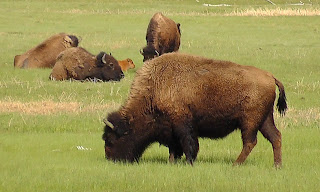Sunday 2nd
June – The day started fine and almost as soon as we left Sheridan we started
climbing up the Bighorn Mountains. This is a range of mountains running NW-SE
for 200 miles east of the Rockies. They are made up of Bighorn National Forest
and wilderness area, up to 13,000 feet. Along the roadside we saw rock
exposures of contorted sediments, often, including the Permo-Triassic Goose Egg
Formation. As we travelled west, we moved further down the geological
succession. We descended
through the Shell River Canyon and stopped at Shell Falls.
Here the river had
cut down into the Precambrian basement granite and formed a gorge. All around
us were towering peaks and precipitous crags. The dominant strata here were the
Bighorn Dolomite and younger Madison Limestone.
At the
bottom of the canyon there was a change to red horizontal sediments, marking a
fault. We called at a roadhouse, Dirty Annie’s, to partake of her fruit pies –
10.30 am! Then we crossed the Big Horn River at Greybull, and then the Bighorn
Basin, arriving at the town of Cody at 12.30.
This town is
a gateway to the Rocky Mountains. En route we watched a DVD about the life of ‘Buffalo
Bill’ Cody whom the town was named after. Cody started his career in the late
1860s as an army scout in the frontier region.
Encounters with Indian tribes followed and Cody later used these
experiences to establish his Wild West shows. In 1888 he took his show and
entourage of 200 players, including Annie Oakley to England and spent the next
five years touring Europe. By 1893, the frontier was considered obsolete with
no new lands to discover.
In the town
of Cody we visited the Buffalo Bill Historical Centre which belies its name. It
is a modern, spacious museum with sections dedicated to natural history and the
Yellowstone area, the life and times of Buffalo Bill, Plains Indians culture,
firearms and modern art. Our two-hour stay was inadequate.
After Cody,
we drove past Buffalo Bill Reservoir, and into Shoshone Canyon. More amazing
rock formations greeted us in red sediments, many of them with names such as ‘Holy
City’, ‘Chimney Rock’ and so on.
This route
led us to the east entrance to Yellowstone National Park. We had a journey of
80 miles to reach our hotel on the west side. Driving on park roads is slow;
this is for the safety of wildlife, and there are frequent stops to take
photographs. We saw some elk and a maternity herd of mother and baby bison
close.
We reached West Yellowstone at 6.30 pm. This is a typical tourist location
with plenty of hotels, restaurants and shops.




No comments:
Post a Comment